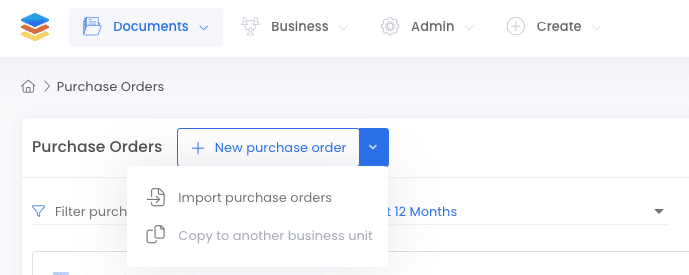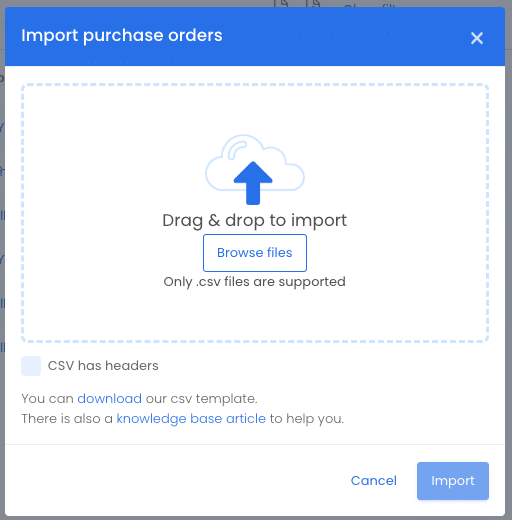Bulk importing orders
You can bulk import orders from a CSV file. Go to the Documents > Purchases pages and select import from the New Purchase Order button. Now download the CSV template.

>
Then download the template from this screen:

Column Headings
The process is straight forward, provided you know how to populate the order CSV file. A copy is shown below.

Line# – Each line in your order needs to be numbered. This field also acts as the break field for a new order. In the example above, this will create a 5 line order to Canon and a 3 line order to Adobe.
Division – Enter the name of the Division exactly as it is in Zahara.
AcctCode – This is the supplier/vendor reference field in your supplier record – not the supplier name.
Date Required – Populate this in the same format as your Business Settings ie Euro, US or ISO.
Currency – The 3 letter ISO currency codes if you aren’t sure. GBP/USD/EUR are the common ones.
Second Ref – This will show if the second ref field is enabled
QTY – Line item quantity.
Product Code – Any product code.
Description – Line item description.
Price – Unit price.
Discount – Any percentage discount without the % sign i.e, just 20 for 20% discount. Put 0 for zero discount. Do not leave blank.
TaxRate – Just the tax % rate without the % sign.
Nominal Code – Just the code – not the description.
Project Code – Just the code – not the name or description.
Cost Code – Just the code – not the description.
Once your order CSV file looks like the one above, try importing it. You will get feedback if there are any errors. If successful, the orders will be created.
The default delivery address under your business settings will be applied as the delivery address.
Import as Draft
If preferred you can have all orders imported as Draft orders. In Business Settings > Purchase Orders, there is a setting to enable this.

Otherwise, all orders will be created and sent into their default workflo
Related Articles
Importing products
Products (inventory) belong to suppliers. So products are imported into individual supplier records. This means when raising purchase orders, you can select products for each line item that have had the pricing and products codes pre-set. Importing ...Importing Suppliers
If you use Xero, QBO or one of the other full integrations, suppliers will be imported as part of the sync. If you use another finance system you can import your suppliers very easily. Head to the supplier list from the Business menu. Importing ...Importing users
Introduction Creating a large number of users? Using our Import Users feature, you can create a large number of users in Zahara at the same time. This is perfect for initial setup as well as to assist in the expansion of your business in Zahara. ...Closing orders automatically
A closed order is simply hidden. It means the purchase order will no longer be displayed in the list views or appear for matching with an invoice. You can easily find closed orders though. They are never deleted. Zahara allows you to automatically ...Import Line Items
When raising an order, as explained on this help article – How to create a purchase order – you can import your line items. You may have all of the items you wish to buy on a spreadsheet. Provided they are in our format, you can import them into the ...